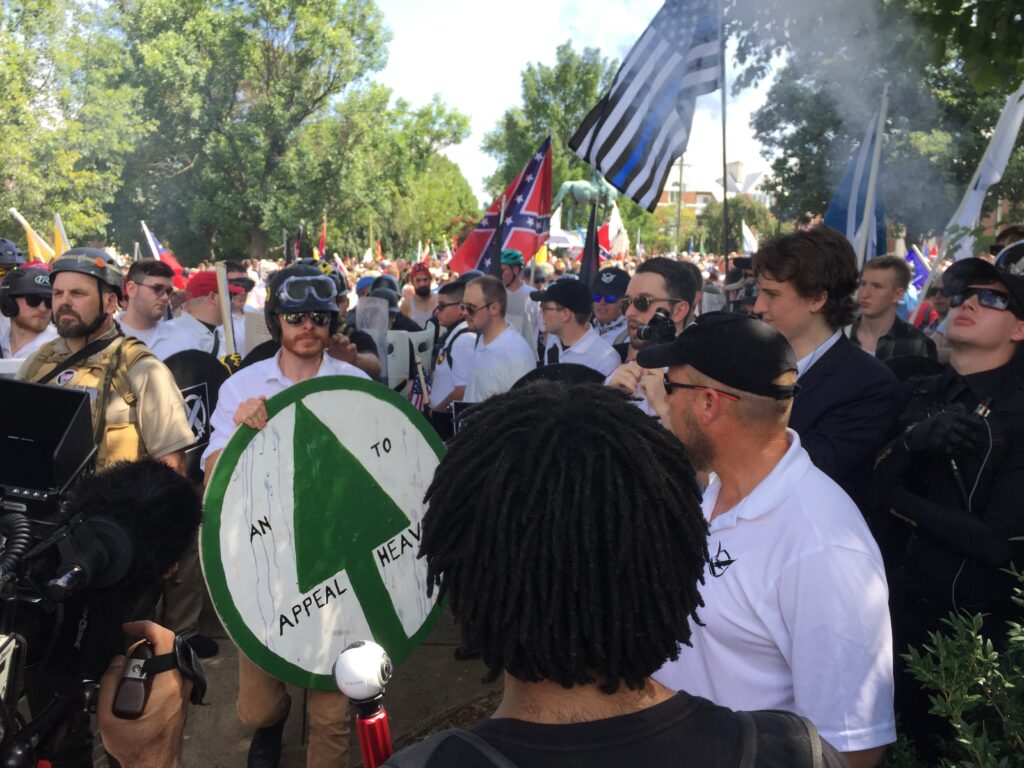Given their fixation on a very particular conception of “tradition,” it should come as no surprise that participants in the alt-right and other closely related movements have regularly adopted language that connects them with figures from the past whose personal mythologies appear useful for their movements’ ends. One manifestation of that is in the very names that participants choose when they want to obscure or alter their identities.
Continue reading “The Alt-Right Name Game”On Borrowed Language and Historical Continuity on the Far Right
One moment from August 12, 2017 that was discussed repeatedly during the course of the Sines trial was the march by members of League of the South (LOS), the Traditionalist Workers Party (TWP), and the National Socialist Movement (NSM) – groups that formed a coalition known as the Nationalist Front (NF) – from a parking garage on Market Street in Charlottesville to what was then called Emancipation Park about two blocks away (the park was previously named Lee Park and has since been renamed once again as Market Street Park). The conflict that occurred when that particular bloc of far right demonstrators clashed with counter-protesters was one of the most dramatic and widely documented events in an already tense and tragic day.

The NF bloc clearly came prepared to fight: many members of LOS and TWP wore helmets and carried uniform police riot shields. A number of them also had flagpoles that quickly became weapons (a practice that was frequently discussed on message boards beforehand). That day in Charlottesville, there were also antifascists who brought helmets, shields, and sometimes flagpoles, but as the NF members approached the park, they were confronted by a line of people who were simply locking arms with little to nothing to protect them. This fact makes the footage of that moment all the more gut-wrenching to watch. Ultimately, the NF groups all made their way into the park.
Continue reading “On Borrowed Language and Historical Continuity on the Far Right”The Sanctifying Language of the Alt-Right
In November 2016, Richard Spencer’s public profile took on a new degree of notoriety when The Atlantic released video of a speech he gave at the annual conference of the National Policy Institute, a white nationalist think tank then under Spencer’s leadership. The comment that yielded the most headlines came at the end when he cried out “Hail Trump! Hail our people! Hail victory!” as he raised a cocktail glass with a straight arm at a high angle to a cheering audience and at least a few Nazi salutes.
The phrase hail victory is, of course, historically linked to that gesture insofar as it is a translation of the German Sieg heil. That pairing of signs – one verbal and one corporeal – was also commonplace among alt-right participants. In a previously recorded deposition that was presented during the Sines trial, former Identity Evropa member Samantha Froelich was asked if she had heard “either Sieg heil or hail victory discussed within the alt-right.” She answered, “yes, at every social event I went to, that was said” and explained that it was associated with “the Roman or Nazi salute.” She even described a joke that was passed around among Identity Evropa members “where you would ask if you’ve seen my friend Kyle. ‘Did you see Kyle?’ Sieg heil? I hope you understand the wordplay here. And then you would do the Sieg heil and say, ‘Oh, he’s right over there’ and point your finger. ‘He’s about this tall’ [indicating a Nazi salute] and that was – that was the joke, is that you’re Sieg heil-ing in plain day.” Continue reading “The Sanctifying Language of the Alt-Right”
Sines v. Kessler: Using the Courtroom as a Public Platform
[The following is part of an ongoing series about Sines v. Kessler, the civil suit against many of the main organizers of the August 2017 Unite the Right (UTR) rally in Charlottesville, Virginia. For an overview of the suit’s objectives and its many defendants, please see the first post in the series here.]
Courtrooms have long been sites for grand ideological statements. Before he was sentenced to hang for the 1886 Haymarket bombing (despite a distinct lack of evidence against him and his co-defendants), August Spies renounced none of his beliefs and instructed the jury that “socialism, in short, seeks to establish a universal system of co-operation.” Before receiving a ten year prison sentence in 1918, Eugene V. Debs declared that “I ask no mercy. I plead for no immunity. I realize that finally the right must prevail. I never so clearly comprehended as now the great struggle between the powers of greed on the one hand and upon the other the rising hosts of freedom.”
As a venue, however, courtrooms are also available to actors with far less noble sentiments. For one example, a week and a half into the Sines v. Kessler trial, it is clear that defendant Christopher Cantwell intends to continuously take advantage of his status as a pro se defendant to bully witnesses in cross-examination, expound on his beliefs, and rehabilitate his tarnished image among his overtly fascist constituency.

By the time he went to prison last year for threats and extortion directed at neo-Nazi rivals, Cantwell had gone from being a popular movement podcaster in the days leading up to Unite the Right to virtual pariah status. The reason for his fall was not so much his aggression toward a fellow fascist or even the infamous teary rant that earned him the “Crying Nazi” nickname, but rather the fact that he had admitted publicly to being an informant for federal agents. Working for domestic intelligence services isn’t exactly uncharted territory among far right actors, but it nonetheless confers a treasonous stench that cannot easily be washed away (as Proud Boys leader Enrique Tarrio has been learning in recent months). Still, as a movement invested in gestures of hypermasculine dominance and obsessed with martyrdom, fascists often reward audacious displays, even when they are strategically ill-advised.
Jury Selection in the Unite the Right Civil Trial and the Limits of Legal Action
[The following is part of an ongoing series about Sines v. Kessler, the civil suit against many of the main organizers of the August 2017 Unite the Right (UTR) rally in Charlottesville, Virginia. For an overview of the suit’s objectives and its many defendants, please see the first post in the series here.]
After two and a half long days of questioning potential jurors, the jury in the federal civil suit Sines v. Kessler has finally been impaneled. The following are some notes about how the jury selection process played out in this case and some of the pitfalls of using the courts to pursue far right actors.
Continue reading “Jury Selection in the Unite the Right Civil Trial and the Limits of Legal Action”Notes on the Upcoming “Unite the Right” Civil Trial: A Guide to Who’s Involved and Why It Still Matters
It’s been over four years since the Unite the Right (UTR) rally in Charlottesville, Virginia on August 11-12, 2017. Since January 6 of this year, those events astonishingly seem destined to be remembered as only the second-most infamous outbreak of mass violence during the Trump era. But if the storming of the US Capitol building is primarily remembered as an attack on institutions, norms, and ideas, UTR stands as a symbol of the visceral and often very personal fear and animosity that drives a great deal of far right activism.
Starting on October 25, the Western District of Virginia will commence the Sines v. Kessler civil trial against a number of the groups and individuals who, the plaintiffs contend, “conspired to plan, promote, and carry out the violent events in Charlottesville.” I plan to attend all or most of the trial and will be posting regular updates here. I was also on-site when UTR happened, so some commentary may be from personal recollection and not exclusively quoted from other sources.

The four years of pretrial motions, arguments, briefs, and hearings leading up to this point have been extraordinarily chaotic and I plan to address some of those details at a later date. In the meantime, as a way of bringing readers up to speed, I’m going to use this introductory post to describe who the players are and just what the purpose of the trial is.
Continue reading “Notes on the Upcoming “Unite the Right” Civil Trial: A Guide to Who’s Involved and Why It Still Matters”
